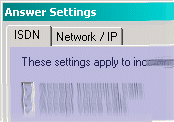|
AudioTX
Communicator Manual
3.
Advanced information: Settings
3.1 Answer Settings: Dual coding capability
- e.g. MPEG3/G.722
3.2 Global Settings: MSN's, Global IP port
settings and the ID string
3.3 Audio Settings: Audio coding quality,
buffering and sample rate conversion
Back to
index page  
| 3.
Advanced Information: Settings |
| 3.1
Answer settings - Dual coding capability |
When answering
an incoming ISDN or Network connection, as part of its built-in
intelligence, AudioTX Communicator detects the coding algorithm,
mode, bitrate and samplerates and adopts the same settings
for the audio data sent back to the calling unit.
Sometimes,
however, you might want to send back audio data using a different
combination of settings. For example, on a radio outside broadcast,
engineers will often want the broadcast to be carried back
to the studio using the highest quality - MPEG3, 128 kbits,
Joint-Stereo - but will want their return or cue feed to use
G.722 for minimum transmission delay. This is known as a dual-coded
connection, and is achieved by setting AudioTX Communicator's
Answer Settings.
The Answer
settings apply to every call received over ISDN and Network
(set in the appropriate window as shown below).
If you
do make changes to these settings whilst experimenting with
the program, remember to set them back for normal operation
afterwards!
|
The
Answer Settings pages allow you to specify how incoming
connections over ISDN and Network should be handled
(properties for outgoing connections that you dial are
set in the phonebook).
|
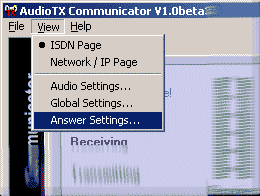
|
|
There
are two tabs - one for incoming ISDN and the other for
incoming Network.
|
|
|
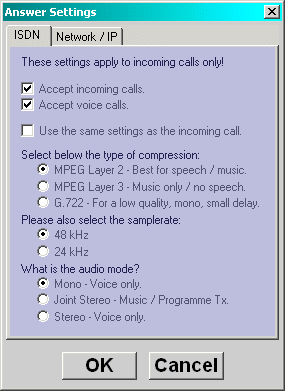
If you want to establish dual-coded connections - e.g.
MPEG2 one way for quality and say G.722 the other way
for a low delay cue feed, you can modify AudioTX Communicator's
behaviour here. This will affect all incoming ISDN calls.
|
Answer
Settings:
ISDN: Accept incoming/voice calls
The
'accept incoming calls' box tells Communicator that
you want to accept incoming connections over ISDN. Similarly,
the 'accept voice calls' tells the program to accept
incoming calls from analog voice telephones (G.711 calls).
Answer
Settings:
Use the same settings as incoming
In
most situations, you should leave the 'Use same settings
as incoming call' box checked. In this mode, the remainder
of this box will be grayed out and when answering a
call, Communicator will send the same coding algorithm
and settings as the incoming connection uses.
Only
advanced users should clear this checkbox.
|
|
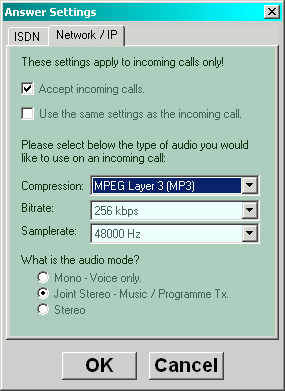
If you want to establish dual-coded connections - e.g.
MPEG2 one way for quality and say G.722 the other way
for a low delay cue feed, you can modify AudioTX Communicator's
behaviour here. This will affect all incoming Network/IP
calls.
|
Answer
Settings:
Network: Accept incoming/voice calls
The
'accept incoming calls' box tells Communicator that
you want to accept incoming connections over IP.
Answer
Settings:
Use the same settings as incoming
In
most situations, you should leave the 'Use same settings
as incoming call' box checked. In this mode, the remainder
of this box will be grayed out and when answering an
incoming IP connection, Communicator will send the same
coding algorithm and settings as the incoming connection
uses.
Only
advanced users should clear this checkbox.
|
...Top of section  ...Back
to index page ...Back
to index page 
| 3.2
Global Settings: MSNs, Network Ports and your chosen name
(ID string) |
|
You
will typically only need to set the information in this
window once.
For
most users, the default settings will be fine...
|
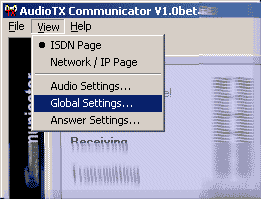 |
|
Global
Settings:
My Identification String
Enter
your name, company name or any other text you want people
connecting to you to see. This will be displayed to
other AudioTX users.
Global
Settings:
My ISDN numbers (MSN)
In
some countries, your ISDN provider will have given you
extra MSN numbers for your ISDN lines - if so, and you
only want AudioTX to accept calls on particular number(s),
enter these in the boxes. You may allocate separate
numbers to channel 1 and 2 or enter the same number
in each.
|
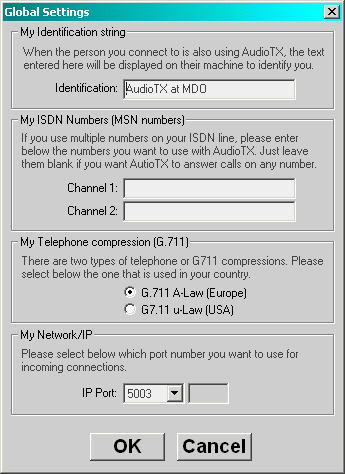 |
|
Global
Settings:
My Telephone compression
AudioTX
can connect over ISDN to an analog (non-ISDN) telephone.
This is known as a G.711 connection.
In
the USA calls between ISDN and analog phones are coded
using u-law. In Europe and most of the rest of the world
it's A-law. If you are unsure, ask your ISDN provider.
|
| |
Global
Settings:
My Network/IP
On
an IP network, each computer has an IP address.
On that computer, each application that uses the
network is also allocated a 'Port Number' - so
that when your computer receives data (or, in
this case, a call) it knows which program to give
it to.
AudioTX
Communicator needs to know what port numbers you
want it to use. The default port of 5003 is fine
in most cases.
|
|
...Top of section  ...Back
to index page ...Back
to index page 
| 3.3
Audio Settings: Audio coding quality, buffering and sample
rate conversion |
|
There
are some additional settings in the 'Audio Settings'
window.
Whilst
rarely used, these are outlined in this section.
|
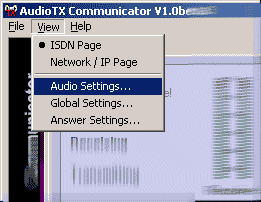 |
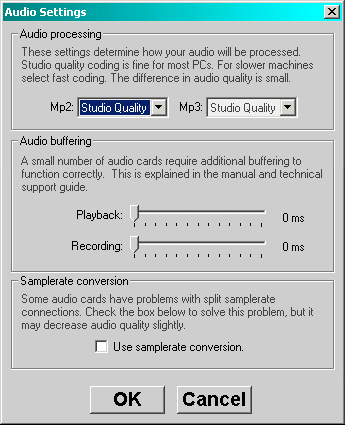 |
Audio
Settings menu: Audio Processing
For
most PCs you should leave these set to studio quality.
On
some slower PCs - where you see the CPU usage at 85%
or above when you try to connect - you may need to set
the MP2 coding value to 'fast coding'. MP3 coding only
has the 'studio quality' setting.
Audio
Settings Menu:
Sample Rate Conversion
Where
an audio card isn't able to use different sample rates
for play and record, AudioTX automatically does the
conversion internally.
|
|
Audio
Settings menu: Audio buffering
For
most Sound Cards, you should use the default values
of 10 ms for both the Playback and Record sliders. If
your system is all working fine, you can try experimenting
with reducing either or both to 0 to reduce your coding
delay even further. If you hear very small clicks or
breaks in the audio sent or received (normally at least
one every second) you may need to try increasing these
values gradually. The Playback slider corresponds to
audio received and the Record slider controls transmitted
audio.
|
However,
some cards report that they are able to do it themselves,
but then just stop. If you have this problem, check
this box which forces AudioTX to do a fast convert for
you.
You
should only switch this on when you need to use it as
it is a lower quality convert than standard!
|
...Top of section  ...Back
to index page ...Back
to index page 
|


![]()
![]()

